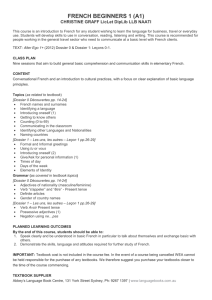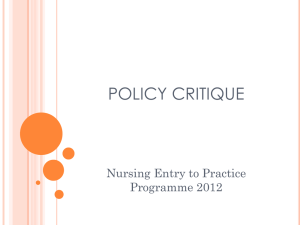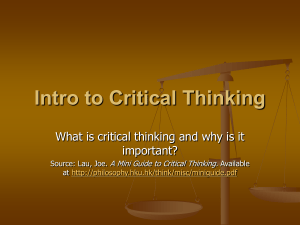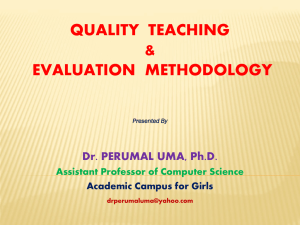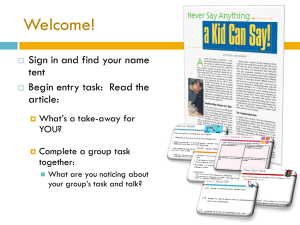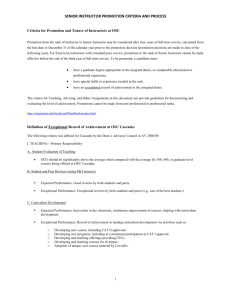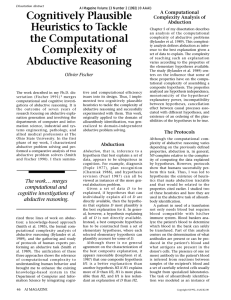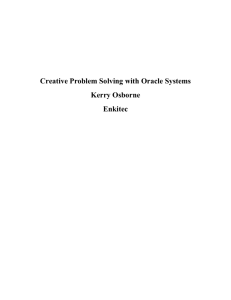The Educator as Designer - Association for Academic Psychiatry
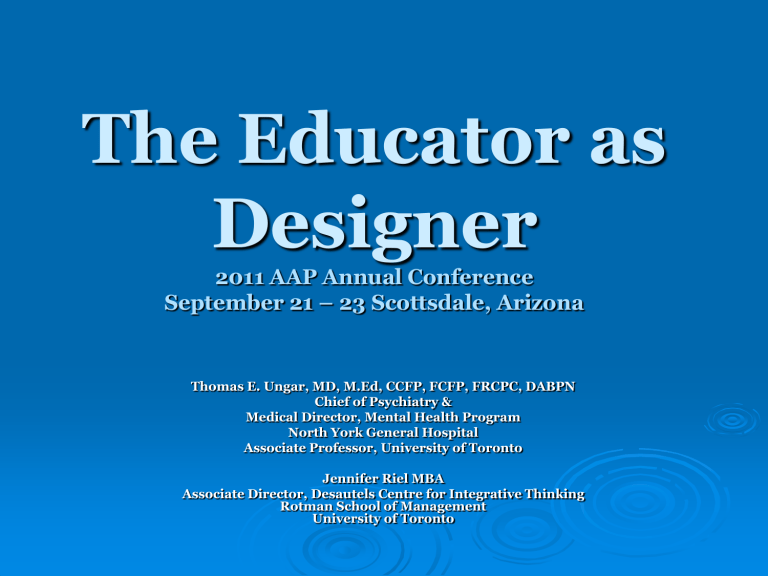
The Educator as
Designer
2011 AAP Annual Conference
September 21 – 23 Scottsdale, Arizona
Thomas E. Ungar, MD, M.Ed, CCFP, FCFP, FRCPC, DABPN
Chief of Psychiatry &
Medical Director, Mental Health Program
North York General Hospital
Associate Professor, University of Toronto
Jennifer Riel MBA
Associate Director, Desautels Centre for Integrative Thinking
Rotman School of Management
University of Toronto
Disclosure Slide
Consultant/Speaker
Astra Zeneca, Lundbeck,
Eli Lilly, Pfizer
Founder/Director
Mental Health Minute®
How I got interested
“ What’s your five year plan?”
Scholarly education studies (contextual learning, transformative learning, hidden curriculum, participant observation, knowledge translation and exchange)
Airport Bookstores– Reading
SARS
Work with family physicians – interdisciplinary collaborative care, deep knowledge of end user
HBR, Globe and Mail national newspaper, Rotman
School speakers, series, books, Jennifer Riel
Learning Objectives
1.
2.
3.
Gain knowledge about the basic principles of
Design Thinking and relate them to their educational activities.
Gain awareness and knowledge of their educational design activities and products, and how to document these for academic promotion and professional rewards.
Reflect on their attitudes and values as to whether educational design constitutes valid scholarly academic activity, and potentially transform their career and educational identities and direction.
Design in Business
Design activity - Project based
Designers care about impact
Design is humanistic, observational, iterative
Definitions
Design thinking can be described as a discipline that uses the designer’s sensibility and methods to match people’s needs with what is technologically feasible and what a viable business strategy can convert into customer value and market opportunity.
~Tim Brown
Design thinking is the “balance (of) analytical mastery and intuitive originality.”
~Roger Martin
The IDEO Approach
Inspiration
Ideation Implementation
The Rotman Model
Observation
In terms of the application of observation to the design of medical education, it is a question of looking beyond what students tell us to understand their deeper-order needs and the needs of the patients they will one day treat. Observation is this case includes attempting to understand the full student experience of engaging with the material, from cracking open to the book, to attending the lecture, to attempting a procedure for the first time.
Imagination
Imagination can be the most difficult skill to acquire. So much of our education, from grade school on, is designed to drive creativity and originality out of us. We kill new or unusual ideas swiftly, before we have a chance to learn anything from them. We dismiss all that we cannot prove in advance. Designers, on the other, use their abductive reasoning to explore what might be possible. They ask what is interesting or exciting about a wild idea, not what is wrong with it. They build and refine quick prototypes to test out ideas and learn all they can from them .
Here, educators can learn from the discipline of prototyping
– testing new pedagogies in rough form and iterating to improve them, rather than attempting to create a perfect final design before rolling it out. Testing and failing early, then learning from that failure, is at the root of innovation.
Configuration
Configuration is the process of fitting the new idea or innovation into a larger system of activities. It is at this point that weaker designers struggle. They foist their brilliant new prototypes on the world without attempting to understand to what extent the new idea fits with existing activities.
It is important to ask, to what extent does a new design fit with current culture and existing protocols? How can it be made to work with them? Can the new design be scaled? Can it be delivered at a cost that fits within our financial constraints? If it cannot, how can we adapt it to do so. The configuration stage is not about compromising the innovation, it is about integrating it into the existing system such that it can be sustained.
The Predilection Gap
Cognitive Errors in Academic
Medical Education
“OR” –all or none thinking-analytic or intuitive thinking
‘AND”- analytic and intuitive thinking –i.e.
Design thinking
Key Differences
Analytical
Thinking
Purpose To prove through induction and deduction
Approach
Exploit existing knowledge
Focus on the past
Venerate data, dismiss judgement and bias
Refine what is
Goal Reliability:
An outcome that is consistent
Intuitive Thinking
To know without reasoning
Design
Thinking
To balance analysis and intuition
Explore new knowledge
Focus on the future
Venerate insight, dismiss analysis
Invent what might be
Explore and exploit
Integrate the past and future
Combine data and insight
Design what should be
Validity:
An outcome that meets the objective
Reliability and
Validity:
A productive balance
The Knowledge Funnel
Expanding the Toolset
Declarative
Reasoning
What is true or false?
• Deductive Logic: The logic of what must be
(reasoning from the general to the particular)
• Inductive Logic: The logic of what is operative
(reasoning from the detailed facts to general principles)
Modal
Reasoning
What could possibly be true?
• Abductive Logic: The logic of what might be
(inference to the best explanation)
Abductive Logic
Novel, surprising or anomalous data
New theory,
“a leap of the mind”
How does that happen? By :
• seeking the best explanation when faced with new or interesting data that does not fit with existing models,
• understanding that the “best” explanation may well not be the simplest, the most obvious or the most accepted, and
• instead of dismissing data that seems to disconfirm one’s model, embracing it as a cue to think about a new explanation.
The Exercise
The challenge: Think of the worst idea ever
Propose ideas for the worst psychiatric residency training you can imagine
Rules for Brainstorming
1) Defer judgment
2) Encourage wild ideas
3) Build on the ideas of others
4) Stay focused on the topic
5) One conversation at a time
6) Be visual
7) Go for quantity
Educational Applications
Design
UG PG CE IPE Public Ed Admin Clinical
Where Does Design live in crusty old academia?
University of Toronto Faculty of
Medicine Promotions Manual:
Planks for promotion 2011
Research
Education
Creative Professional Activity
Hollenberg Report on Creative
Professional Activity 1983
It is not assumed that CPA and traditional academic excellence are mutually exclusive or that they can not manifest themselves in the same individual
Professional innovation/creative excellence is expressed in performance, film, and exhibition or staging of a work of art, original architectural or engineering design, original clinical or therapeutic techniques, introduction of an original concept in approaching a professional problem, etc.
2011 U of T Promotions Manual
3.2.1.1 Professional Innovation and Creative
Excellence
Development, introduction and dissemination of an invention, a new technique, a conceptual innovation or an educational program. Creative excellence, in such forms such as biomedical art, communications media, and video presentations, may be targeted at various audiences from the lay public to health care professionals.
Presenting/Showcasing Design
Activity for Academic Promotion
Education-Teaching Dossier
Curriculum Design
Instructional Design
Creative Professional Activity Dossier/Portfolio-
Educational Design Portfolio
Projects/conceptual innovations/designs/products
Outcomes
Impact Statements
Utilization
Dissemination Figures/Examples/Testimonials
Tom’s CPA Dossier
Educator’s Statement
“The Creative Professional Activity in this dossier demonstrates a model of education that recognizes the need for contextualization of information along the knowledge cascade between research, specialist clinician, primary care physician and public. Each new context, practice culture and practitioner therefore requires an attempt at creative redesign of the style, placement, methods and language if effectiveness is to be expected. Ultimately the educational scholarship requires design activity, which for me is primarily an innovative and creative process complementing the foundation of scientific medicine .”
Educator’s Statement
cont;
“Each creative professional activity and Innovation in
Primary Care Mental Health Education is approached as a knowledge translation problem requiring an instructional design solution that takes in to account the differing contest of primary care mental health delivery. This leads to creative and innovative curriculum materials, designs, products, and practice and learning enablers. To the specialist psychiatrist these may appear to be unconventional dilutions of specialty knowledge .”
Educator’s Statement
cont;
“Contributions in Instructional Design and Innovation demonstrate the scholarship of synthesis of knowledge as well as the scholarship of knowledge translation or implementation science.”
Rewards/Protections
Educational Designs - “Products”
Intellectual Property
Copyright
Trademarks
Patents
How to Create a Design
Friendly Environment
Organizational
Personal
Thank You
Primary Care/Family Doctor
Education Example
Reality GP video
Clinical Design Example –
Pandemic Plan
CMAJ Publication on
Pandemic Plan
Public Education Design
Why Design thinking for medical education? relevance?
Link to educator skill sets, natural affinity for teachers, who understand learners, student or end users and deep understanding of context – empathic design etc
Examples of medical education instructional design-curriculum design, educational tools, acronyms, mnemonic device creation, video creation, case writing, simulation design, games, knowledge translation materials, interventions, social media public health campaign strategy and products etc.
Educational Design to assist identity formation for medical educators – faculty development and career validation
Challenges for design thinking in reliability oriented world of medicine and science, where educators and clinical teaching is second or third fiddle to research
How to document and present educational design activities-the educational design portfolio-creative professional activity dossier
Challenges for academic institutions to recognize and evaluate meaningful impactful non traditional academic educational design activity
It’s in our interest to embrace design thinking to enhance the field of medical education and innovation.
AAP Workshop Outline
10 minutes Introduction
Disclosure Slide
Learning Objectives
How I got Interested
Design Thinking Primer – PowerPoint 20 minutes
Abductive Reasoning Exercise
Psychiatric
Educator Applications
Promotion & Documentation
CPA Dossier/Design Portfolio
Design Products - Example
Educational Identity Formation
20 minutes
30 minutes
How to Create a Design Friendly Environment 10 minutes
Organizational
Personal
Evaluation

